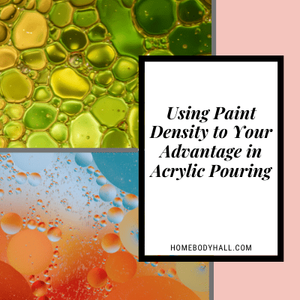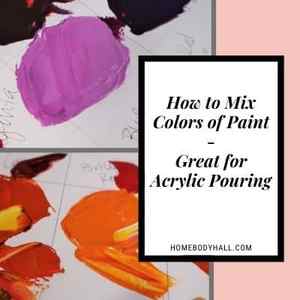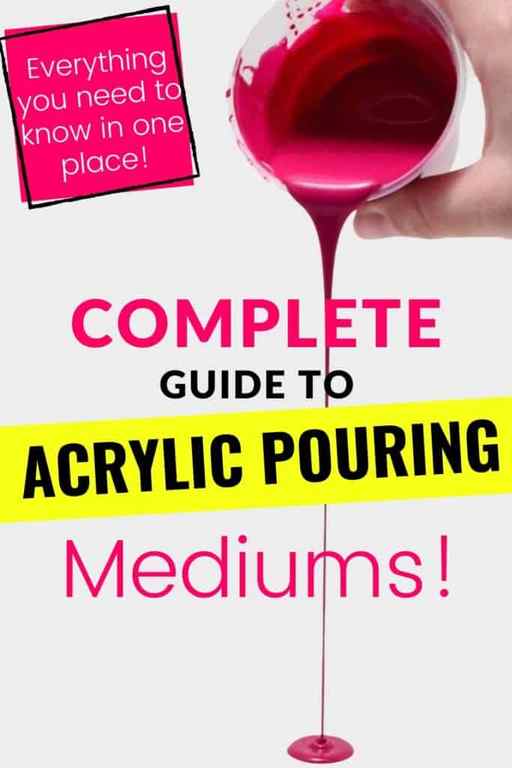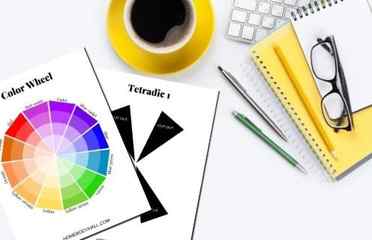Yet, I would like to say that this is 100% DIY and I would not recommend it to use with artist-grade expensive paints or for paintings you are planning to sell. Simply because nobody can guarantee how durable this mix will be after it dries.
How to Rehydrate Acrylic Paint: 14 Good & Bad Ways To Soften Acrylics
Acrylic paint is easy-to-use, versatile, and water-soluble paint. Thus, it’s no wonder that it’s a popular art medium. Everyone can use it for fun and relaxation as you don’t need special skills to be able to use it. Some artists and hobbyists may store some paints and find out dried out acrylic paints. If this happens to you, learning how to rehydrate acrylic paint is the solution.
Even though acrylic paint is water-soluble you can only rehydrate acrylic paint that has some moisture and is still glossy. You can dilute acrylic with warm water or acrylic flow improver. Once acrylics dry you cannot rehydrate or reactivate the paint.
This article will guide you on rehydrating dry acrylic paint and even prevent it from drying out. Read on to save the dried up paint! I will go over easy methods, some risky DIY ways, and extra tips for keeping paint from drying. I will be honest with you and tell if I think it is a good or bad method to try.

Contents show
Why is my acrylic dried out or hard?
Acrylics are water-based with pigments floating in resin. The evaporation of water causes the acrylic to dry and form a plastic-like film on the surface. This process makes acrylic paint water-resistant and not washable and it takes only up to 30 min.
Reasons why you have hardened acrylic paint:
- The old paint was exposed to a lot of air. This effect also takes place when you forget to put the lid back on.
- Direct sunlight or extreme temperature (both cold and extreme heat) gets into the area where the paint is stored.
- You may have failed to mix the paint properly before use.
- An excessive amount of water was added to the paint before application.
- Putting too much paint on the palette as acrylic paint can dry in just a matter of 10 to 20 minutes.
- Paint with low quality will likely dry out even if it’s still in the paint container as it has a meager amount of pigments and no-name binders.
How to rehydrate acrylic paint (all methods upfront):
- ✅ Warm water
- ✅ Fluid medium
- ❌ DIY flow aid medium (risky, I do not recommend, but people still do it)
- ✅ Flow improver
- ❌Toothbrushing dried paint with water or alcohol (risky, I do not recommend, but people still do it)
- ❌Add oil paints (risky, I do not recommend it, but people still do it)
- ❌Add acetone (risky, I do not recommend, but people still do it)
- ❌Household Method with soda (risky, I do not recommend, but people still do it)
- ❌Microwave (risky, I do not recommend, but people still do it)
- ❌Add fresh paint and mix in blender
- ✅ Sanding (to fix dried paint on canvas)
- ✅ Glazing liquid
- ✅ Gesso
- ✅ Pouring medium
So ultimately, most of DIY methods recommended online won’t work. I understand people said it worked for them, but if we truly understand the composition of acrylic (polymer, pigment, preservatives, water) we won’t add dishwasher to it and expect it to be artist-grade brand new paint. Let’s stay rational, my friends!
Let’s look at each method in detail and you can decide for yourself whether to try in or not! If you tried something else and it worked, email me!
How to rehydrate acrylic paint if it is too hard/thick

Don’t lose hope when you see your acrylic paint that turned dense, and heavy. There’s a chance to revive it with warm water and a flow improver as long as the paint has a little moisture in it.
This method also helps if you think you have thick heavy body paint and you want to make it more fluid.
1 – A drop or more of warm water
Warm water is like a magical potion in restoring acrylic paint that turns hard and clumpy. It doesn’t only work wonders but it doesn’t thin out the paint. The temperature of water improves the paint’s solubility.
After adding a drop of warm water, stir the paint with a small toothpick or a wooden stick. If you feel it is not enough, add little more water. It’s best to let it sit overnight and check the outcome the following day. Before you leave it, make sure that the pods are tightly sealed to prevent air from messing it up.
Make sure to not add more than 25-30% of water to your paint,if you will add too much water you will end up with watery paint.
This method may not work with fabric acrylic paint.
2 – Flow improver
Using a flow improver is one way to put hardened or thick acrylic paint into use. Unlike warm water, flow aid mediums don’t break acrylic paint composition and only improve the consistency.
You can directly mix it with paint or prepare a cup with water to wet your paintbrush and put a few drops of flow improver in it. This is done before you start painting.
The Max ratio is 25% of flow aid to paint.
Dip your brush into the cup then into your paint. You’ll notice that the brush moves smoothly over the painting surface. But you should be aware that flow improver thins the paint and it may turn more transparent.
If these methods didn’t work your paint is not just thick, it started to really dry out, the hard paint doesn’t have a bit of moisture left.
What is Consistency?
When we talk about consistency, we’re talking about the flow and texture of your paint, medium, and additive mixture.
When it comes to acrylic pouring, which is fluid art, obviously the mixture has to be easy to pour! There are a few common household items you can compare your consistency to—sometimes this can help you to visualize what your paint should look like.
A few things that resemble a good pouring consistency:
- Warm honey
- Motor oil
- Chocolate syrup
Essentially, your mixture should be free flowing but not drippy. It should not drop heavily in clumps off of your stirring utensil, or run off quickly as if you had dipped your utensil in water. When you pull your stirring utensil out of the paint mixture, the paint should flow off easily and evenly.
On a side note, to complement your Acrylic Pours, I highly recommend using a Cricut Machine (my personal favourite is the Explore Air 2 machine) to design and print yourself beautiful crafts on all sort of supports. Check it out here! Now back to common consistency issues.
Common Consistency Issues
Very Thin Paint
If your paint is too thin and runny, you’ll want to add a bit more paint. Add just a little at a time and keep stirring in between additions.
Very Thick Paint
If your paint is too thick, more medium is needed. Again, add a little more at a time to arrive at the desired consistency.
It’s really crucial to only add a little paint or a little medium at a time. You can always add more, but you can’t take away what you’ve added, and it’s no fun doing the dance back and forth between adding paint and adding medium!
Common Brands & Ratios
- Liquitex Basics + Liquitex Pouring Medium: Liquitex states on their website that you should use about 5% paint and 95% medium. For example, if you’re using 10 total ounces of paint, you’ll want to use a half ounce of paint, and 9.5 ounces of medium.
- Liquitex Basics + Floetrol: You can use three parts Floetrol to one part Liquitex. For example, if you want four total ounces of paint, you’ll use one ounce of paint, and three ounces of medium.
- Golden Fluid Acrylics + GAC 800: According to Golden’s website, the maximum recommended ratio is 10% fluid acrylics to 90% GAC 800. Golden states that the optimal usage rate would be 1-5% fluid acrylics. They also explain that any paint concentration above 10% may “overwhelm the GAC 800’s resistance to crazing”. GAC 800 is wonderful for preventing those pesky cracks and crazes, so this is sage advice to follow.
- Nicole’s Craft Paint (or other thin craft paint) + Floetrol: Thinner paints require more medium and less paint typically. However, because craft paints aren’t always as pigmented as professional artist paints, you may need to mix at a one to one ratio with these paints to get the desired color.
Consistency can be frustrating, but not impossible to master. If you’re using one of these combinations and it’s just not working for you, come talk to us! We have a great group on Facebook (search for Acrylic Pouring), and there are thousands of artists who can help!
Sara Wagner is an author and artist from Upstate New York. She is the owner of Studio Blackwater and can typically be found covered in paint, cats, or her two young daughters. You can find her on Facebook and Instagram as @studioblackwater.
Professional Mediums
| Product | Retailers | Price (U.S. Dollars) | Size | Star Rating |
|---|---|---|---|---|
| GAC 100 | Amazon Blick Michael’s |
$11.33-20.99 | 8 oz. | 4.75 |
| GAC 800 | Amazon Blick Michael’s |
$11.33-20.99 | 8 oz. | 4.7 |
| Liquitex Pouring Medium |
Amazon Blick Michael’s |
$29.12-39.99 | 32 oz. | 4.4 |
| DecoArt Pouring Medium |
Amazon Blick Michael’s |
$9.98-12.30 | 16 oz. | 3.77 |
| Pebo Studio Acrylics Prouing Medium |
Amazon Blick |
$11.99-15.00 | 250 ml | 5 |
| Chroma Atelier Pouring Medium |
Blick | $9.61 | 8 oz. | 5 |
| US Art Supply Gloss Pouring Effects Medium |
Amazon | $23.96 | 32 oz. | 4.1 |
| Mont Marte Premium Acrylic Flow Medium |
Amazon | $15.99 | 16.9 oz. | 4.4 |
| Sargent Art Acrylic Gloss Medium |
Amazon | $18.93 | 32 oz. | 4 |
| Sargent Art Acrylic Pouring Medium |
Amazon | $9.79-13.60 | 16 oz. | 3.9 |
| Novaplex 233 | Nova Color | $13.50 | 1 quart | |
| Novaplex 235 | Nova Color | 1$13.00 | 1 quart | |
| Solo Goya Pouring Fluid Acrylic Medium |
Amazon Kraftika |
$24.52-27.62 | 500 ml | 2.5 |
| Viva Decor Pouring Medium |
Amazon | $12.31 | 0.5 Liters | 4.2 |
| Vallejo Pouring Medium |
Blick | $16.50 | 500 ml | 4.4 |
| Folkart Pouring Medium |
Amazon Michael’s |
$9.99-13.71 | 16 oz. | 5 |
| Tri-Art Liquid Glass Pouring Medium |
Blick | $19.27 | 500 ml | 5 |
| Chromacryl Pouring Medium |
Blick | $13.24 | 16 oz. | |
| Artist’s Loft Pouring Medium |
Michael’s | $12.99 | 16.9 oz. | 4.1 |
| Hand Made Modern Paint Pouring Medium |
Target | $7.99 | 8 oz. | |
| Amsterdam Acrylic Pouring Mediums |
Jerry’s Artarama | $13.99 | 250 ml | 5 |
| Lukas Acrylic Pouring Mediums |
Jerry’s Artarama | $13.69 | 500 ml | 4.4 |
| Impresa Products Pouring Effects Medium | Amazon | $24.99 | 32 oz. | 3.4 |
| Product | Retailer | Price (U.S. Dollars) | Size | Star Rating |
|---|---|---|---|---|
| Flood Floetrol | Amazon | $6.97 | 1 quart | 4.7 |
| Flood Floetrol | Home Depot Lowe’s |
$13.97 $14.67 |
1 gallon | 4.6 |
| Wagner Paint Easy Latex Paint Conditioner | Amazon | $13.98 | 32 oz. | 4.6 |
| Owatrol | Amazon | $16.84 | 1 liter | 4.4 |
| XIM Latex X-Tender Flow and Leveling Additive | Amazon | $27.85 | 1 gallon | 4.3 |
PVA Glues
| Product | Retailer | Price(U.S. Dollars) | Size | Star Rating |
|---|---|---|---|---|
| Elmer’s Glue-All | Amazon | $14.97 | 1 gallons | 4.7 |
| Lineco Neutral pH Adhesive | Amazon | $10.18 | 8 oz. | 4.3 |
Now that you know how to thin acrylic paint for pouring, you’re all set to get started experimenting and creating beautiful art!!
I’ve gotten quite a few questions from people looking for mediums in different places around the world, and I think your best bet would be to look for either PVA glue or a water-based latex paint conditioner at a hardware store.
If you’re pouring for the first time and would like more explanation on materials, processes, and terms, you can head on over to my Beginner’s Guide to Acrylic Pouring. You can also head over to my Comprehensive Guide to Acrylic Pouring Techniques for more information on all of the different techniques.
And If you’re curious about colors and color theory as it relates to acrylic pouring, head on over to my post about Choosing Colors for Acrylic Pouring and grab your FREE printable Color Wheel and Color Scheme Guides.
As always, check out my updates on Facebook and Instagram and feel free to peruse Homebody Hall for more fluid art tips, tricks, and tutorials! Also head over to Youtube and subscribe to get my videos sent to you as soon as they come out!!

Using Paint Density to Your Advantage in Acrylic Pouring

How to Mix Colors of Paint (Great for acrylic pouring!)

43 Genius Gift Ideas for Artists into Acrylic Pouring
Want to remember how to thin acrylic paint pouring? Be sure to pin this to your favorite Pinterest board!


Primary Sidebar
About
My goal is to share my fluid art experiences with you, my successes and my failures, in the hopes that you can pick up some new ideas and learn from my adventures to save you some time, hassle, and money along the way. I really want everyone who wants to be creative to have that ability, and I truly think that fluid art is an awesome art form to facilitate that!


FREE Printable Color Wheel and 8 Color Scheme Guides!
Tired of using the same colors over and over? Not sure what colors go together? Grab my FREE Printable Color Wheel and 8 Color Scheme Guides and take your pouring to the next level!
You’ll also be signed up to receive awesome projects and helpful info as well!





